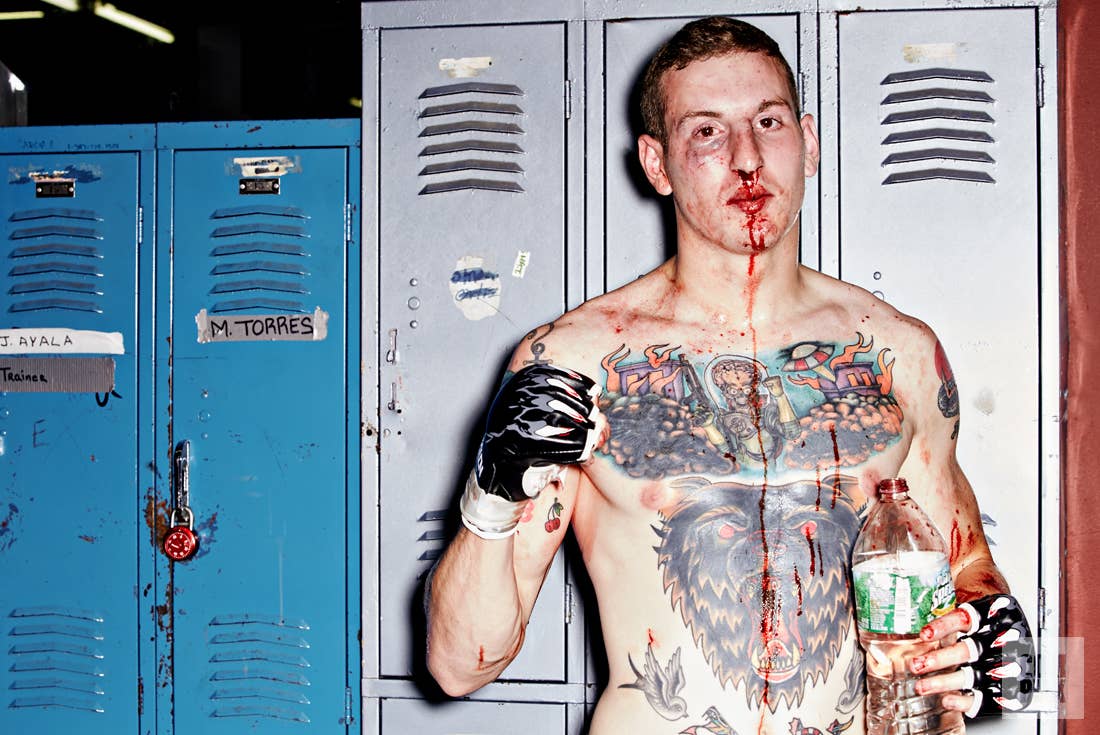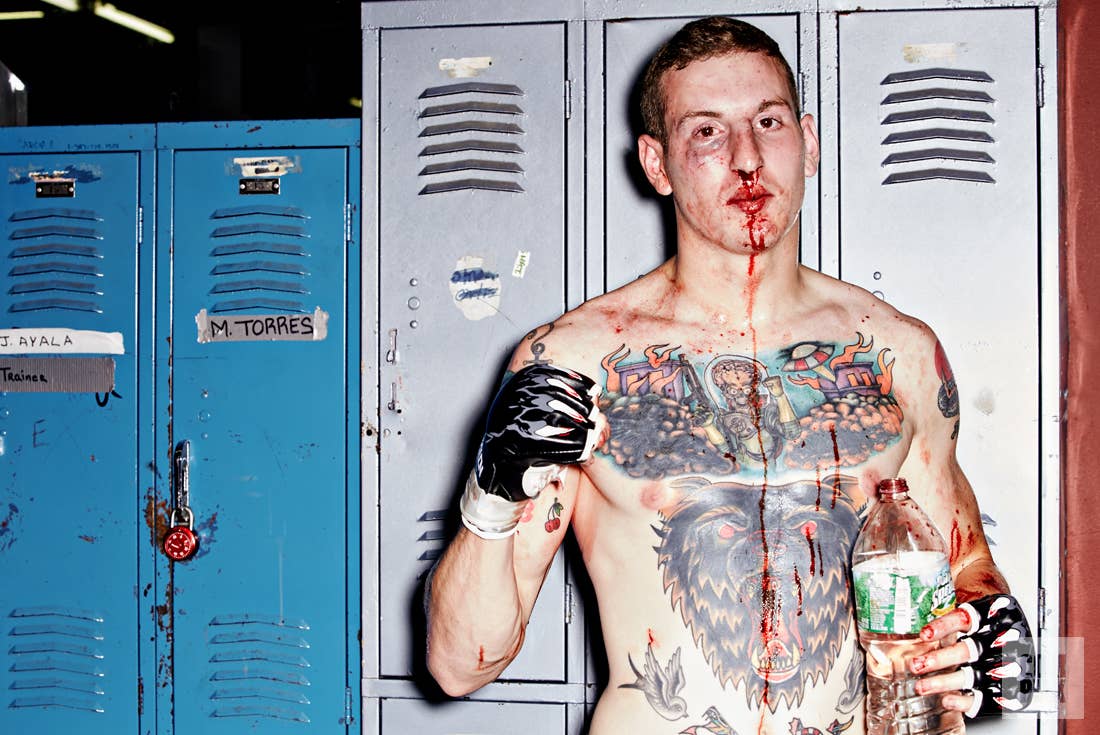
Forty seconds into the first round of the last-ever Underground Combat League show, a stray hunk of jewelry draws first blood. Back in his corner, the Taekwondo master repping Harlem, who had been holding his own in a grapple, has a dull bit of cheap gold-painted earring piercing his left calf muscle.
“The fuck is this, a fashion show?” the corner man asks.
If you have been following the Underground Combat League (UCL) for the full 13 years of its existence—most of those as the only mixed martial arts game in New York City—you already know that this is par for the course. Until very recently, if you wanted to see MMA in this town, you accepted it might include some unwanted body modification.
The man behind the DIY scene of sharp elbows and questionable legal decisions is 39-year-old Peter Storm, the owner, proprietor, and occasional combatant of his own underground fight club. Seeing that the Taekwondo fighter is ready to go on, Storm gestures for the match to continue. By round two, the fighter proves he's recovered, stampeding his opponent into submission with punch after exhaustive punch. Toward the end, Taekwondo guy isn’t even keeping his gloves up for protection after throwing a shot. The kid he’s battling collapses under the ropes and Storm and the rest of the ringside team rush over to revive him. The Taekwondo master is declared the winner by KO.
Storm—who's diminutive for a MMA fighter but possesses the kind of strength you don't earn doing curls for hours in the gym—calls it “a good start.”
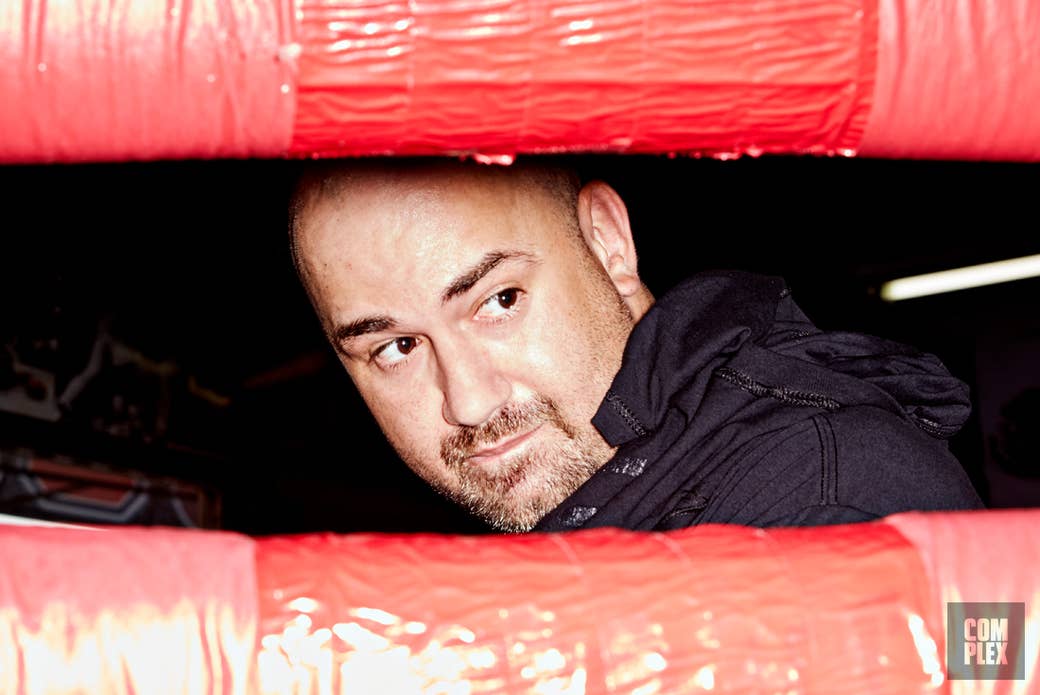
In April, New York became the last state to legalize mixed martial arts (MMA). After Gov. Andrew Cuomo signed Senate Bill S5949B into law, UFC quickly booked Madison Square Garden for November, when it will hold its first-ever show in the Empire State. The New York State Association of Counties has been tasked with installing governing regulations, referees, judges, and medical staff ready to handle the sport by the end of August. This is a world without a place for Storm and the UCL.
“We’re known as a take-no-prisoners, come-as-you-are fight league,” Storm tells Complex before the day's bouts begin. “If New York MMA is professionalized, and I bring the UCL into that, it won’t be the UCL anymore.”
So when Storm climbed into the ring of a Bronx boxing gym on this early August Sunday afternoon, it was to announce what many in attendance already knew: This was the end of the UCL.
In the last 10 years, cavernous MMA gyms with $200-a-month membership fees have become fashionable, courting pupils hooked by professional UFC trainers who could teach but weren't allowed to practice the sport unless they crossed state lines. Storm, on the other hand, favors crumbing boxing gyms, and The Bronx hoards them. Off-hours fistic temples are UCL favorites; ceilings ripped apart to tie punching bags to the steel girders above, faded bout announcements of once promising students thumb tacked to the walls. The space housing the UCL's last fight—its name hidden out of respect for whatever deal Storm struck with its owner—is no different. Fighters crouch before a massive steel fan after a fight because there's no A/C. Rows of blue plastic chairs are filled with longtime fans, friends of competitors, and one young boy stomping his dinosaur toys along the lowest ring rope. This is where Storm plans to ride off into the sunset.
“New York City’s amateur
MMA ranks are full of competitors. But they aren’t full of fighters. Fighters are guys who aren’t scared of nobody. The UCL is about fighters.”
There was a time when, if you wanted to go to a league show, it was best if someone vouched for you. The underground illegality was part of the attraction, and once your name was on the list you had been accepted into a conspiracy of outlaws. You might get a text message 24 hours before doors opened giving you a time and a place. It might be an email two weeks out telling you to save the date—the actual location would come a week later. The shuffle was more likely a symptom of Storm’s problems booking a venue than staying ahead of the law, but either way, it added to the romance. Currency among these fans consists mainly of boasting about the most gruesome injury you’d seen or remembering the weirdest venue you were summoned to. One ringside spectator in the Bronx recalls the time a fighter refused to get into the ring five minutes before a match and was replaced by a willing fan—a fan who would be left with a compound leg fracture in the basement of a mosque. The injured might get cab fare to the hospital, but never an ambulance.
“You never know what you’re going to get” is an axiom used by UCL devotees both to express joy after some brutal brawl or to brush aside a disappointing fight. The men who stepped into the ring at the UCL were college age or in their early 40s, veteran strikers or unseasoned rookies, self-trained in their apartments or paying big money at a name-gym for lessons with a UFC pro.
But training is not a reliable indicator of performance. One of the promotion’s most dominant fighters, Kaream Ellington, is now semi-retired with a leg injury at 34, perfected his neutron-bomb Superman punch by imitating Street Fighter II. Instead of a bell, the signal to begin each bout was left to the mountainous bald referee who would clap his hands together between combatants and order, “Fuck each other up!”
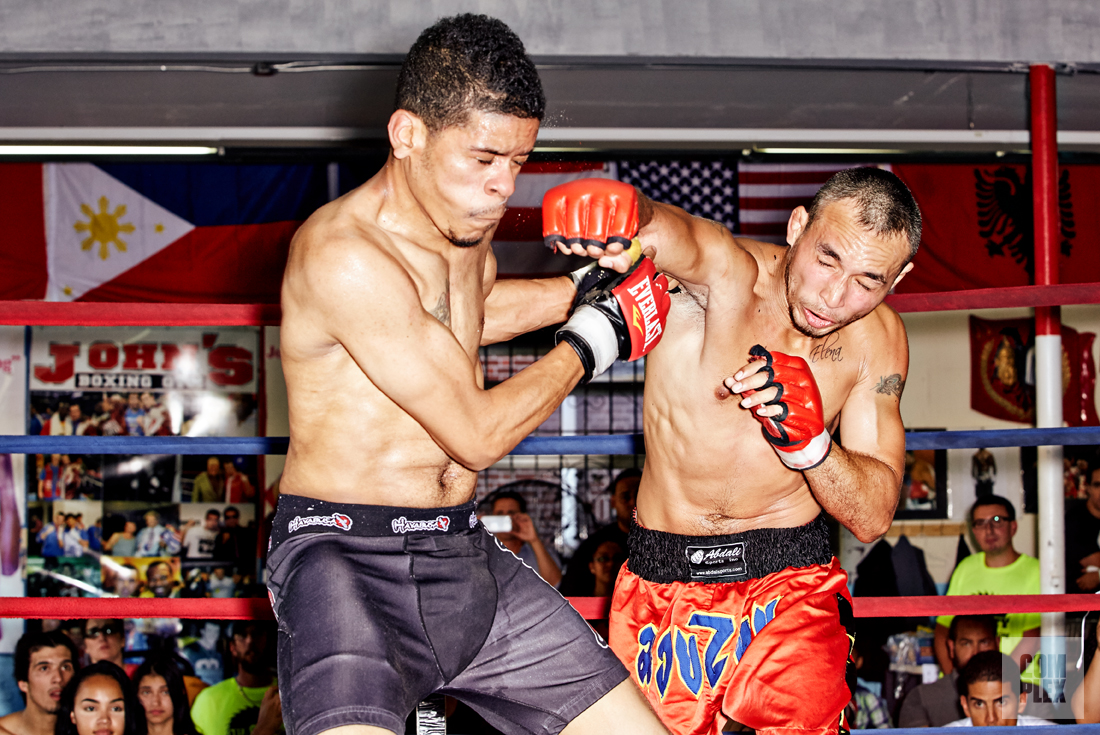
In this last venue—surrounded by walls decorated by fading posters of old fighters, inspirational slogans, and at least one Albanian flag bearing a portrait of Mother Teresa—Storm wants to go out on top.
“It’s like in the Godfather, where they talk about how there’s a difference between a war-time consigliere and a peace-time consigliere,” says Jim Genia, managing editor of CagedInsider.com and author of Raw Combat, a book about the struggle to legalize MMA in the Empire State. “Peter Storm was a war-time fight promoter. He’s the man we needed when no one would host a show.”
Longtime UCL photographer Anil Melwani has another take. “Now that everything’s legalized, you need almost $100,000 just to pay for everything you need to put on a show—doctors, a bond, security. Peter Storm works as a bouncer. He has his own security company, but he’s a blue-collar guy. There isn’t any room for blue-collar guys anymore.”
The beginning of the end came in 2013, when New York state attorneys conceded that amateur MMA was legal under state codes as a way to dodge a suit over allowing legal professional bouts. By the end of the year, 47 amateur bouts had taken place across the state, compared to the previous average of seven a year for most of the decade. Of those seven fights a year, almost all were UCL shows.
Almost overnight, the city’s trendy neighborhoods were hosting Muay Thai and Brazilian Jui Jujitsu bouts while gyms sold expensive memberships to Wall Street types and trust-fund hipsters. People likely to use the phrase "farm to table" expanded their vocabulary to accommodate "rear naked choke." All of a sudden promoters were expected to go through sanctioning bodies and get their fighters' medical records.
“There are older fighters out there who don’t want to go through all the time and the testing and the blood work just so they can get a bout. They just want to step in the ring and fight,” Storm says. “New York City’s amateur MMA ranks are full of competitors. But they aren’t full of fighters. Fighters are guys who aren’t scared of nobody. They’re the kind of guys who just get in the ring and fight no matter what. The UCL is about fighters.”
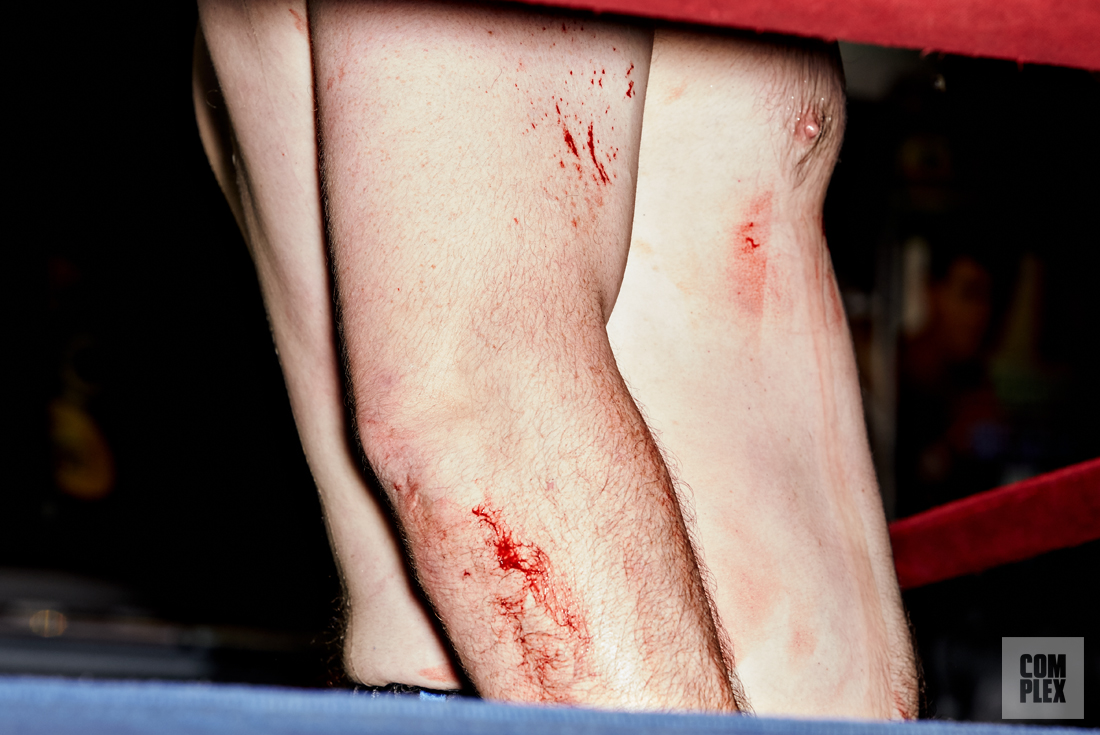
Storm’s shows may have had a certain integrity in their unregulated violence, but at the same time they became an industry standard for what not to do. Competing promoters advised amateurs not to work UCL shows. And Storm, who places a premium on loyalty among the ranks, found himself working with fewer hands. Things looked even worse for the League after Nick Lembo of the New Jersey Athletic Control Board told Deadspin in 2014 that several amateur NYC fighters had been refused matches in other states after testing positive for HIV and Hepatitis C, all but specifically calling out the UCL by name.
“I’m not disputing anything. It’s possible that story has some validity to it but I doubt it because of the source,” Storm says. “[Lembo is] kind of throwing New York MMA under the bus. The fact that a guy who’s always been against NY MMA, who’s never done anything productive about getting MMA in New York legalized, would say that stuff, I have a huge problem with that. It would surprise me if it were true. That story made it seem like it was an epidemic or something. Most New York City promoters are full of shit. I hear stories from other promoters about how they scan fighters coming in and it’s like they all had the same PR guy—they have the same sound bite. The bottom line is: Without me there would be no amateur MMA in New York.”
From here on out, he doesn’t know if he has a future in MMA beyond watching the shows. He hints that he’s talked to other clubs about work, maybe coaching, maybe promoting, but nothing is set. He only knows for sure that this is the end of the league he built, that it’s outlived its own usefulness.
“I just wanted somewhere I could see the kind of fighting I wanted to see,” says Storm. “You’ll never see a league like this again. You’ll see a lot of shows with a lot of money, making money off the door and not giving it to the fighters so they stay ‘amateur.’ But you won’t see a place where anyone who wants to fight can fight.”
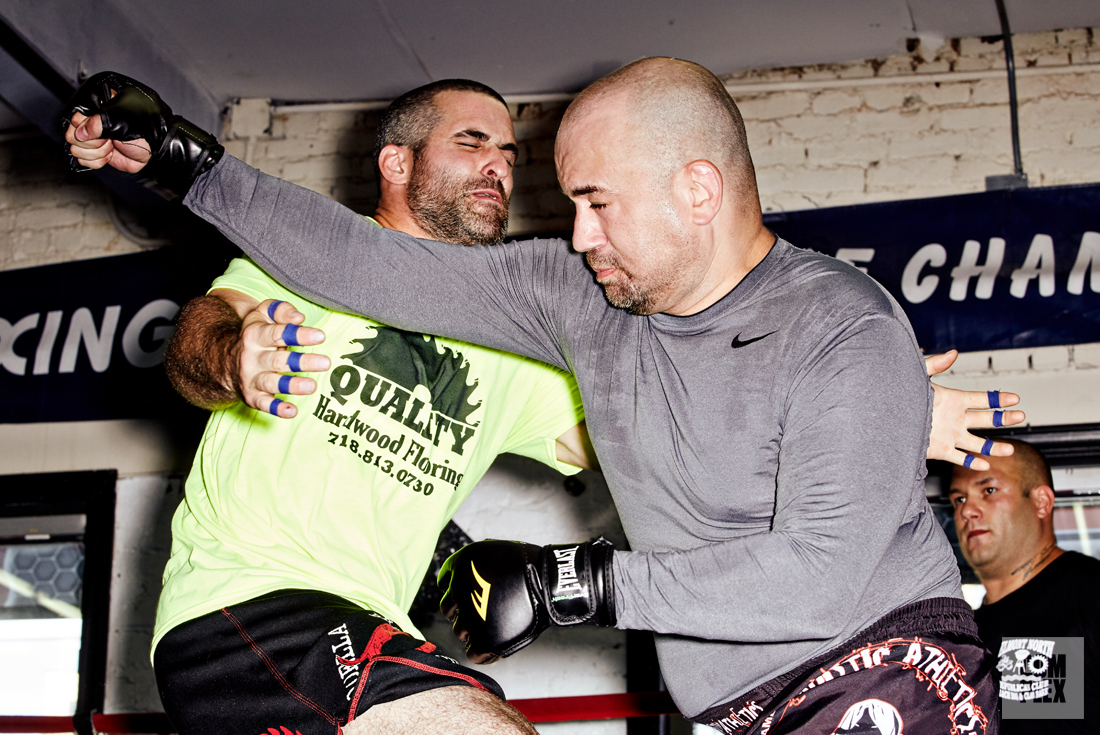
The final show has been an honorable memorial. A stray shot to the testicles holds up one fight for as many minutes as the victim needs to walk it off before he's pummeled. A lanky fighter whose torso is divided between a Mars Attacks tattoo across the chest and a howling wolf across the stomach barely acknowledges the blood gushing out of his nose. No taxis are needed to the ER.
The final match of the day, the final match for the UCL, is also Storm’s final match as a fighter. t's essentially for the promotion’s permanent title. Management has its benefits.
Normally Storm steps into the ring and sports a red gi with a dragon embroidered across the back, but this Sunday he’s going out in a simple grey tee. For the first and only time a UCL combatant opts for the subtle option.
While locking up with opponent Brad Corbett, it looks like Storm might take the belt home. Corbett tries to put Storm on the ground with a hip toss, but the UCL president ends up on top and goes into a ground-and-pound that lasts until the end of the first round.
Both men come out swinging in round two, and when Storm goes in for a grappling takedown you can sense the fight’s event horizon coming. They fall together, and as Corbett steadies himself on his rear it's clear that Storm has let himself get locked into a choke. Corbett moves slowly up until he’s bent at the knees, holding Storm’s throat in a standing guillotine. It’s hard to tell if Storm taps, or if it’s the referee who runs in to end it.
The whole match has taken no more than five minutes, and the last unsanctioned MMA brawl in America ends with the outlaw Peter Storm wheezing against the ropes.
“Fuck,” Storm says. “Fuck, fuck goddammit.”

